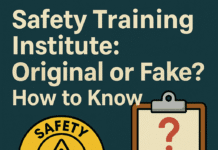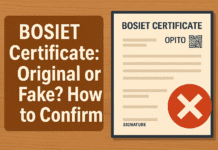
Safety Management Certification: Ensuring Workplace Excellence
Safety is paramount in any workplace, and organizations worldwide are increasingly recognizing the significance of safety management certification. In this comprehensive guide, we will delve into the nuances of safety management certification, exploring its benefits, types, processes, challenges, and the evolving landscape of workplace safety.
Introduction to Safety Management Certification
Definition and Importance
Safety management certification refers to the formal recognition of an organization’s commitment to creating a safe and secure working environment. It involves adhering to established standards and protocols to mitigate risks and ensure the well-being of employees.
Key Industries Benefiting from Certification
While safety management certification is applicable across various industries, it holds particular relevance in sectors such as manufacturing, construction, healthcare, and logistics.
Benefits of Safety Management Certification
Workplace Safety Enhancement
The primary goal of safety management certification is to enhance workplace safety. By implementing standardized safety measures, organizations reduce the likelihood of accidents and injuries.
Legal Compliance
Certification ensures compliance with local and international safety regulations, shielding organizations from legal repercussions. It provides a structured framework for meeting legal obligations.
Positive Impact on Company Reputation
A certified commitment to safety significantly enhances a company’s reputation. Clients, customers, and partners often prioritize businesses with a proven dedication to employee well-being.
Types of Safety Management Certifications
ISO 45001: Occupational Health and Safety Management
ISO 45001 is an internationally recognized standard that outlines the requirements for an occupational health and safety management system. Achieving this certification demonstrates a commitment to creating a safe and healthy workplace.
OHSAS 18001: Occupational Health and Safety Assessment Series
OHSAS 18001 is a widely adopted certification, providing a framework for identifying and controlling health and safety risks. It helps organizations establish systematic processes to improve performance.
Safety management certification is a process through which individuals or organizations can demonstrate their commitment to ensuring a safe and healthy work environment. It involves obtaining a certification from a recognized authority or certification body that confirms compliance with established safety standards and practices.
There are various types of safety management certifications available, depending on the industry and the specific focus of safety concerns. Some common certifications include:- OSHA Certification: The Occupational Safety and Health Administration (OSHA) in the United States provides various certifications related to workplace safety. These certifications cover a range of industries and safety practices.
- ISO 45001 Certification: The International Organization for Standardization (ISO) offers the ISO 45001 certification, which is an international standard for occupational health and safety management systems. It provides a framework for organizations to improve employee safety, reduce workplace risks, and create better, safer working conditions.
- NEBOSH Certification: The National Examination Board in Occupational Safety and Health (NEBOSH) offers certifications that are recognized globally. These certifications cover a broad spectrum of occupational health and safety topics.
- CSP Certification: The Certified Safety Professional (CSP) certification is awarded by the Board of Certified Safety Professionals (BCSP) in the United States. It is a widely recognized certification for safety professionals across various industries.
- ASSE Certification: The American Society of Safety Professionals (ASSP) provides certifications such as the Certified Safety Professional (CSP) and the Associate Safety Professional (ASP), indicating a level of expertise in the field of safety.
- IOSH Certification: The Institution of Occupational Safety and Health (IOSH) offers certifications that focus on enhancing safety management skills and knowledge.
Obtaining a safety management certification often involves completing specific training programs, passing exams, and meeting certain experience requirements. It not only demonstrates a commitment to safety but also enhances the credibility of individuals and organizations in the eyes of clients, regulators, and other stakeholders.It's essential to research and choose a certification that aligns with the specific safety needs and standards relevant to your industry or profession.Process of Obtaining Safety Management Certification
Preparing for Certification
The journey to safety management certification begins with thorough preparation. This involves assessing the current state of safety protocols, identifying gaps, and establishing a roadmap for compliance.
Engaging in Risk Assessments
Understanding workplace risks is crucial. Organizations must conduct comprehensive risk assessments to identify potential hazards and implement preventive measures.
Implementation of Safety Measures
Certification requires the implementation of safety measures outlined in the chosen standard. This may involve upgrading infrastructure, adopting new policies, and training employees.
Documentation and Audits
Accurate documentation of safety processes is critical. Regular internal audits and assessments by certification bodies ensure ongoing compliance and improvement.
Obtaining safety management certification involves several steps:- Preparation: Understand the specific requirements of the chosen standard (e.g., ISO 45001) and assess your organization’s current safety practices against those requirements.
- Implementation: Develop and implement a safety management system that aligns with the chosen standard. This may involve creating policies, procedures, and processes to address occupational health and safety risks.
- Training: Ensure that employees are trained on the new safety management system and are aware of their roles and responsibilities in maintaining a safe workplace.
- Documentation: Keep detailed records of safety policies, procedures, and any incidents that occur. Proper documentation is crucial for the certification process.
- Internal Audits: Regularly conduct internal audits to assess the effectiveness of the safety management system and identify areas for improvement.
- Certification Audit: Engage a third-party certification body to conduct an audit of your safety management system. If the system meets the required standards, the certification body will issue the certification.
Maintaining safety management certification involves ongoing commitment to continuous improvement and compliance with the established standards. Certification provides tangible evidence of an organization's dedication to creating a safe working environment, enhancing its reputation, and potentially reducing the risk of accidents or incidents.It's essential to choose a recognized and reputable certification body when seeking safety management certification to ensure that the process is credible and widely accepted in the industry.Common Challenges in Safety Management Certification
Initial Resistance and Employee Buy-In
Employees may resist changes initially. Effective communication and involvement in the certification process can help overcome resistance and gain employee buy-in.
Cost Considerations
Investing in safety management certification involves costs. However, the long-term benefits, including reduced accidents and improved reputation, often outweigh the initial financial outlay.
Continuous Improvement
Sustaining a commitment to safety requires ongoing effort. Continuous improvement strategies are necessary to adapt to changing circumstances and emerging risks.
Successful Case Studies
Companies with Exemplary Safety Records
Examining successful case studies highlights the positive impact of safety management certification. Companies with exemplary safety records often experience increased productivity and employee satisfaction.
Positive Outcomes Post-Certification
Organizations that prioritize safety often report reduced accident rates, improved employee morale, and enhanced operational efficiency after obtaining safety management certification.
The Role of Leadership in Safety Management
Top-Down Commitment
Leadership plays a pivotal role in fostering a culture of safety. When leaders prioritize and champion safety initiatives, employees are more likely to embrace and adhere to them.
Creating a Safety Culture
Embedding safety into the organizational culture requires continuous communication, training, and leading by example. A strong safety culture is the foundation for successful certification.
Integration with Other Management Systems
Aligning Safety with Quality and Environmental Management
Integrating safety management with existing quality and environmental management systems creates a holistic approach to organizational excellence. It streamlines processes and ensures consistency.
Global Recognition and Market Competitiveness
Attracting Clients and Partners
Safety-conscious organizations attract clients and partners who prioritize working with entities committed to the well-being of their employees. Certification enhances market competitiveness.
Staying Ahead in the Global Market
In an increasingly globalized market, safety management certification is a differentiator. It positions organizations as leaders in safety practices, attracting international opportunities.
Continuous Improvement Strategies
Regular Reviews and Updates
To maintain certification relevance, organizations must conduct regular reviews and updates to their safety management systems. This ensures ongoing alignment with industry best practices.
Employee Training Programs
Investing in ongoing employee training programs keeps staff informed about the latest safety protocols. Well-trained employees are crucial for maintaining a safe work environment.
Industry-Specific Certifications
Tailoring Certifications to Industry Needs
Certain industries have unique safety challenges. Tailoring certifications to address specific industry needs ensures a more targeted and effective approach to safety management.
Specialized Requirements for Various Sectors
Some sectors, like healthcare or construction, may have specialized safety requirements. Achieving sector-specific certifications adds an extra layer of credibility and relevance.
Myths and Misconceptions About Safety Management Certification
Addressing Common Misunderstandings
Dispelling myths surrounding safety management certification is essential. Common misconceptions may deter organizations from pursuing certification when, in reality, the process is adaptable and beneficial.
Clarifying the Certification Process
Providing clear and concise information about the certification process helps organizations make informed decisions. Transparency is key to dispelling uncertainty.
Conclusion
In conclusion, safety management certification is not just a regulatory requirement; it’s a commitment to the well-being of an organization’s greatest asset – its people. By investing in certification, companies not only enhance workplace safety but also fortify their reputation, attract valuable partnerships, and stay ahead in a competitive global market.
Frequently Asked Questions (FAQs)
- Is safety management certification mandatory for all industries?
- No, while it’s not mandatory for all industries, many sectors benefit from safety management certification, especially those with inherent risks.
- How long does it take for a company to obtain safety management certification?
- The duration varies based on the organization’s size, complexity, and existing safety protocols. On average, it can take several months to a year.
- Are there specific certifications for niche industries like IT or healthcare?
- Yes, there are industry-specific certifications that cater to the unique safety challenges of sectors such as IT, healthcare, and construction.
- Can small businesses afford safety management certification?
- The cost of certification varies, but there are often resources and grants available to help small businesses navigate the process.
- What happens if a company fails a safety management certification audit?
- If a company fails an audit, it receives feedback on areas of improvement. It can then address these issues and undergo a reevaluation.





















